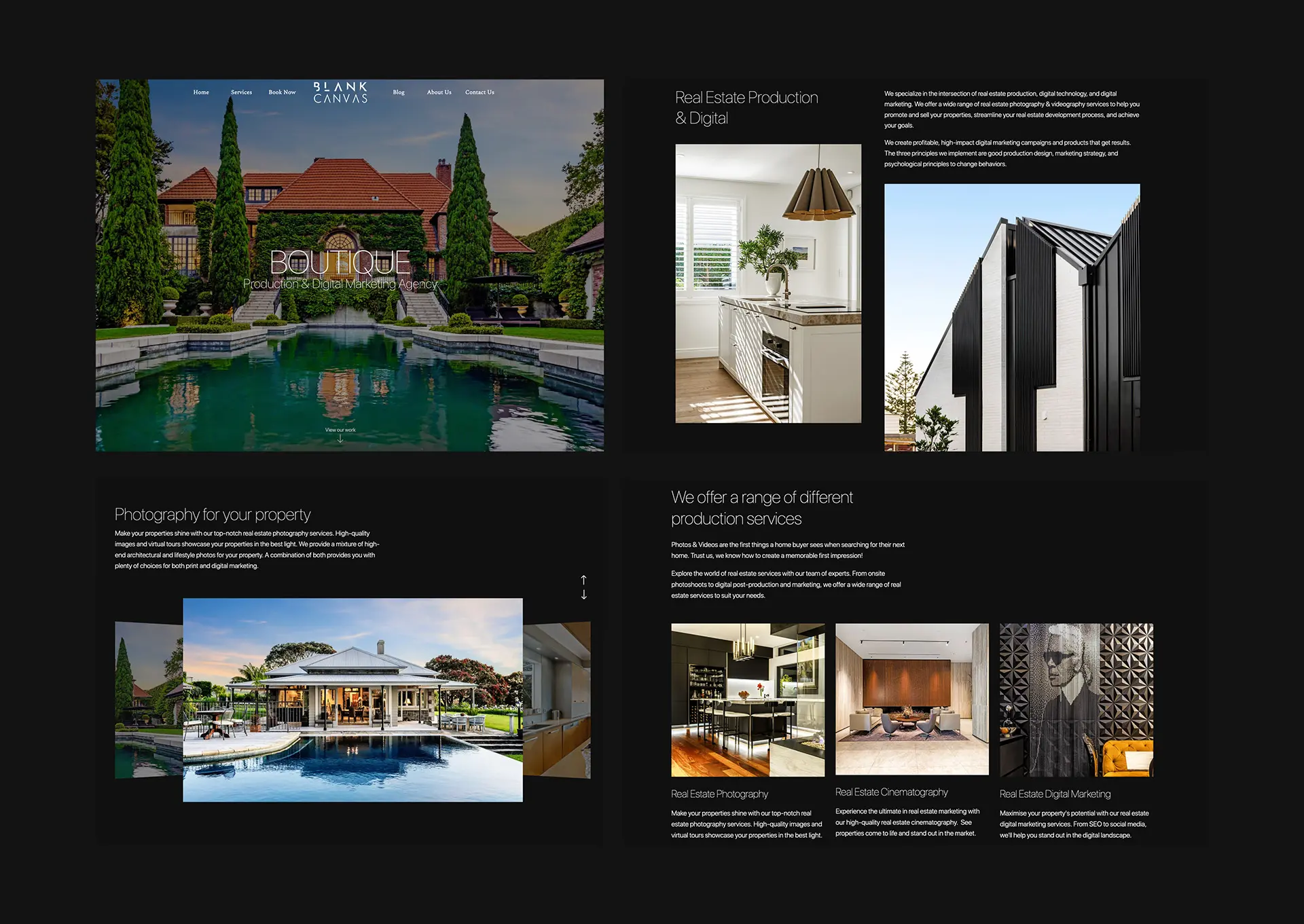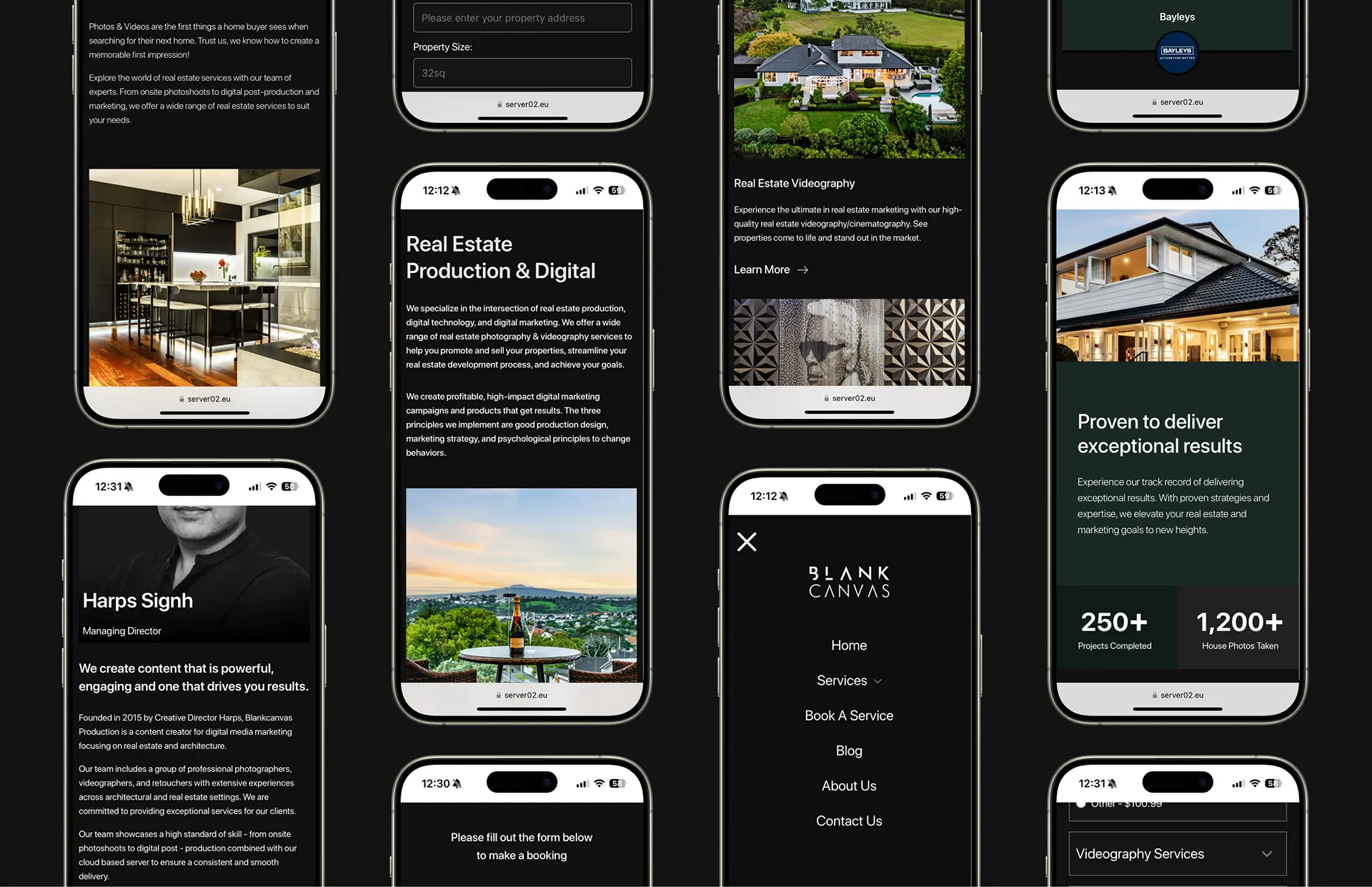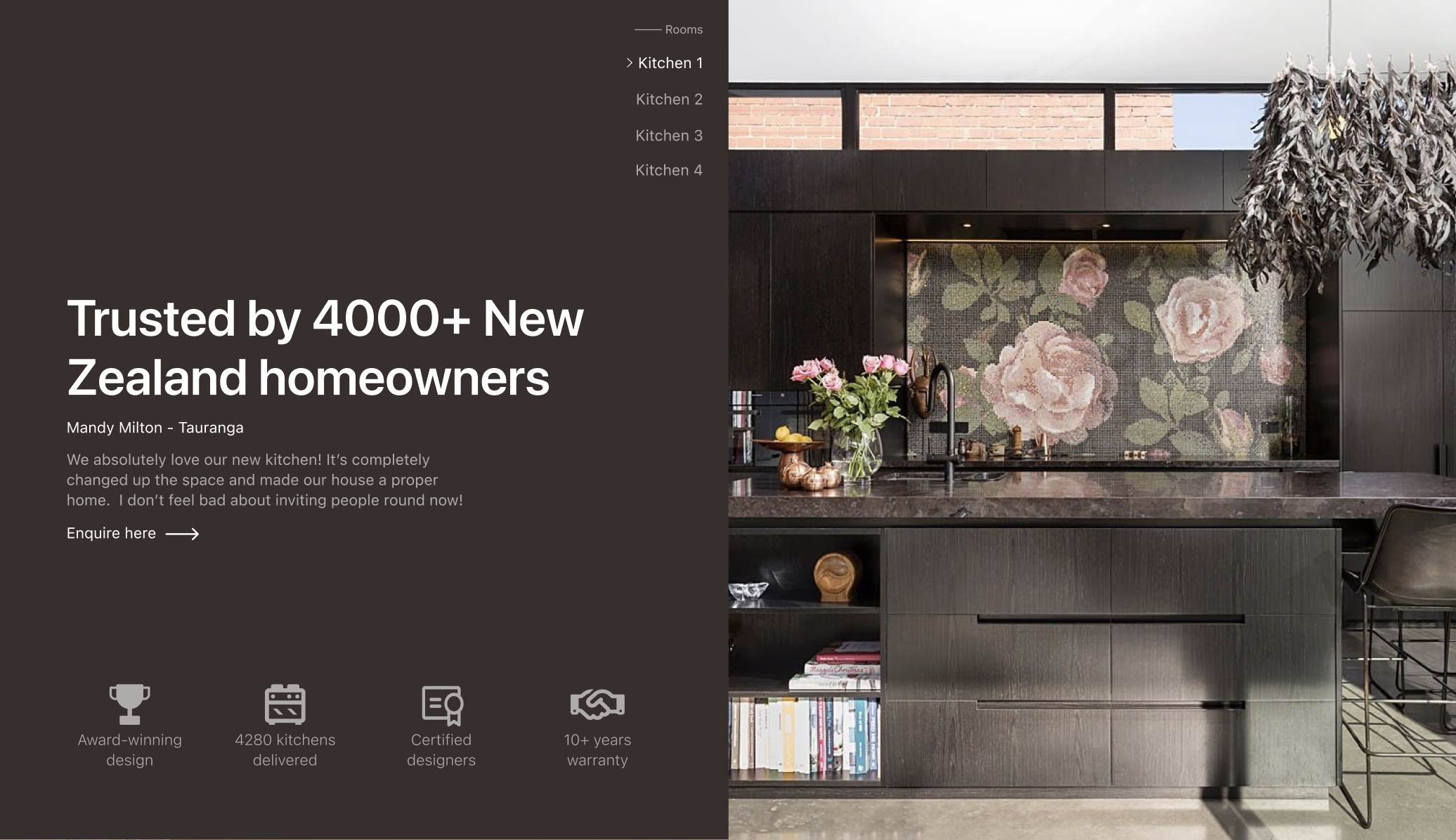Most Crucial Features for Your Real Estate Website in 2025
Discover the top features for real estate website design in 2025! Learn how mobile responsiveness, lead capture tools, high-quality visuals, and SEO can transform your site into a powerful lead generator

In 2025, over 97% of home buyers start their property search online. That’s not just a number; it’s a clear signal to real estate agents and agencies that your website is no longer just an accessory. It’s your primary storefront, handshake, and first impression, all rolled into one.
But here’s the kicker, not all websites are designed and developed equal. A slow website or a missing feature could mean potential clients clicking away and straight into your competitors hands. On the flip side, a well-designed real estate website can generate leads while you sleep, showcase your expertise, and establish your reputation as a leader in your market. It’s not just about being online, it’s about standing out.
Whether you’re looking for a digital design specialist or dreaming of a high-end website design that takes your business to the next level, this guide will break down exactly what your site needs to thrive in the competitive 2025 real estate market. From mobile responsiveness to lead capture tools, we’ll unpack the features that deliver ROI and attract buyers and sellers like magnets.
Let’s dive in and build a website that’s not just another real estate site – it’s your competitive edge.
Unlocking the Power of Selling Property Online
Your website is more than a digital placeholder – it’s a lead generator, reputation builder, and your 24/7 salesperson for selling property online. With 97% of homebuyers starting their search online, having a professional, functional, and engaging website is the foundation of success. It increases visibility, attracts local buyers and sellers, and solidifies your authority in the market.
Investing in a platform that incorporates search engine optimisation in New Zealand and website development company expertise means better rankings, more traffic, and ultimately, more clients.
But, isn’t it hard?
Building or redesigning a website might seem daunting, but with the help of real estate web dev companies like Builtflat, it’s surprisingly accessible. Using WordPress website design and development, creative agency website design, or pre-built real estate templates, you can achieve a stunning and functional site at a fraction of what you’d expect. Many tools simplify the process, making professional results achievable for businesses of any size.
Top 9 Real Estate Website Features in 2025
User-Friendly Navigation
What Is User Friendly Navigation?
User-friendly navigation ensures visitors can seamlessly move through your website without confusion or frustration. It simplifies the user journey, allowing potential buyers and sellers to access listings, contact forms, and resources quickly. For real estate websites, where users are often searching for specific properties or insights, clear navigation is essential.
Imagine walking into a store where the aisles are mislabeled, and the staff can’t direct you – it’s frustrating. The same applies to a cluttered website. Proper navigation transforms your site and web pages into a space where users feel guided and comfortable.
Why Is user-friendly navigation Important?
User-friendly navigation isn’t just about aesthetics. It’s about functionality that drives business outcomes. Here’s why it matters:
- Keeps Visitors on Your Site Longer: Easy navigation encourages users to explore more pages, reducing bounce rates.
- Increases Conversion Rates: Clear paths to contact forms and listings make it more likely visitors will take actionable steps.
- Enhances User Experience: Visitors will perceive your site as professional, organised, and credible.
- Improves SEO Performance: Search engines favour sites with low bounce rates and logical structure. In turn this boosts rankings, getting you more potential customers.
Mobile Responsiveness
What is mobile responsiveness?
Mobile responsiveness ensures that your website adapts to any screen size, whether it’s a desktop, tablet, or smartphone. When creating a website, it involves designing your site so all elements – from navigation bars to images – resize and reorganise automatically for a smooth mobile experience.
With more than 60% of web traffic coming from mobile devices, having a responsive website isn’t a bonus – it’s a necessity. A mobile-friendly site ensures that users get the same high-quality experience, no matter what device they’re on.
Why is mobile responsiveness important?
Mobile responsiveness impacts both user experience and business performance. Here’s why it’s highly recommended:
- Broader Reach: A mobile-friendly site ensures you cater to the growing number of users browsing from smartphones and tablets.
- Higher SEO Rankings: Google prioritises mobile-first indexing, meaning your mobile site heavily influences rankings and gets you higher on the search engine results page.
- Enhanced Credibility: A responsive site signals professionalism and makes your brand appear more trustworthy.
- Improved Conversion Rates: Mobile-friendly designs remove barriers for on-the-go visitors, increasing the chances of lead generation.

High-Quality Visual Design
What are high quality website visuals?
High-quality visuals – images, videos, and virtual tours – transform how your properties are perceived online. These assets provide a rich, immersive experience that helps potential buyers connect emotionally with a property before they even visit in person.
Why are high quality visuals important in web design?
Strong visuals aren’t just aesthetic; they play a key role in engaging users and driving sales. Here’s why:
- Improves First Impressions: Quality images immediately signal professionalism and attention to detail.
- Engages Visitors Longer: Visuals capture attention and keep users on your site, reducing bounce rates.
- Builds Emotional Connections: Buyers can imagine themselves in the space, increasing inquiries.
- Differentiates Listings: Strong visuals make your properties stand out in crowded markets.
Lead Capture Forms
What are lead capture forms?
Lead capture forms are essential tools for gathering contact information from visitors. These forms can offer valuable resources like home valuations, market reports, or downloadable guides in exchange for user details.
Think of it as your first handshake with a potential client. By offering something valuable, you earn their trust and open the door for future conversations.
Why are lead capture forms important for my real estate website design?
In the digital era, capturing leads is non-negotiable for scaling your business.
Here’s why it matters:
- Converts Traffic into Leads: Visitors who fill out forms move closer to becoming clients.
- Builds a Client Database: You’ll have a pipeline of leads to nurture over time.
- Drives Targeted Marketing: Contact information allows for personalised & targeted follow-ups.
- Improves ROI: Lead capture tools reduce dependency on expensive advertising since you own that contact information from the go.
Blog and Content Marketing
What is blog and content marketing?
A blog allows you to share articles, guides, and insights about the real estate market, positioning you as an expert. Content marketing attracts, informs, and engages your target audience.
For example, just as we’re doing – writing blogs about “landing pages” or “the benefits of website design for business” can draw local clients searching for answers.
Why is it important?
Content marketing drives organic traffic, educates potential clients, and builds trust.
Here’s why blogging matters:
- Improves SEO: Blogs are a great SEO strategy and optimise your site for relevant keywords like “real estate” or “property developers”.
- Attracts Leads: Helpful content brings in users actively searching for real estate advice.
- Builds Authority: Demonstrates your expertise in the market and builds trust.
- Enhances User Engagement: High-value content keeps users on your site longer.
Testimonials and Reviews
What are website testimonials and reviews?
Testimonials and reviews are client endorsements that validate your professionalism and expertise. They serve as social proof, helping potential clients trust your services.
Think of it as word-of-mouth marketing – but on a much larger scale.
Why are they important?
Positive reviews have the power to influence decisions.
Here’s why they’re vital:
- Builds Trust: Testimonials reassure clients of your credibility.
- Differentiates You: Unique success stories help you stand out from competitors.
- Improves Conversions: Buyers and sellers are more likely to engage after reading positive reviews.
- Boosts SEO: Reviews linked to Google My Business can improve local search rankings.

Contact Info and Inquiry Forms
What are these?
Your contact information and inquiry forms make it easy for potential clients to reach out. These elements are often the final step in converting visitors into leads. Whether it’s a phone number, email address, or live chat, providing multiple touchpoints ensures users can get in touch in the way they prefer.
Inquiry forms, on the other hand, simplify the process of sending specific questions or requests, creating a seamless experience for potential clients.
Why are contact info and inquiry forms important?
Contact details and inquiry forms are the bridge between you and your prospects.
Here’s why they matter:
- Encourages Immediate Action: Users are more likely to contact you if the process is simple and visible.
- Builds Trust: A prominently displayed address and phone number enhance credibility.
- Increases Conversions: Easy access to contact forms turns visitors into clients.
- Supports Customer Service: Inquiry forms ensure clients can ask questions even after hours.
Analytics and Tracking Tools
What are analytics and tracking tools for the web?
Analytics tools like Google Analytics and CRM systems track website performance, visitor behaviour, and lead-generation metrics. These tools provide valuable insights into what’s working on your site and where improvements can be made.
Think of it as having a pulse on your website’s health. Data-driven decisions are key to optimising your online presence.
Why are they important for my real estate website design?
Without analytics, you’re navigating in the dark. These tools help you make informed decisions.
Here’s why analytics are crucial:
- Tracks Traffic: Know where your visitors come from and what they’re looking at.
- Measures Conversions: Understand what’s driving users to take action (or what’s stopping them).
- Improves Marketing ROI: Focus on strategies that deliver measurable results.
- Identifies Weaknesses: Pinpoints pages or features that may need adjustment.
Social Media Integration
What is social media integration?
Social media integration connects your website to platforms like Facebook, Instagram, LinkedIn, and X (formerly Twitter). It allows users to easily share content and engage with your business across multiple channels.
Embedding social media links or live feeds ensures your website feels dynamic and connected to real-time activities.
Why is it important?
Social media is where conversations happen, and your website should be part of that dialogue.
Here’s why it matters:
- Increases Visibility: Shares and engagement expand your reach to new audiences.
- Drives Traffic: Social media users clicking through to your site boosts traffic.
- Enhances Credibility: Active profiles show you’re current and involved in your industry.
- Creates Lead Opportunities: Social links encourage cross-platform engagement.
How These Can Be Cost-Effective
Building or redesigning a real estate website doesn’t have to break the bank. By strategically selecting tools, platforms, and services, you can create a high-performing website while staying within budget. Here’s how:
Leverage Open-Source Platforms Like WordPress
Platforms like WordPress are free to use and highly customisable, making them ideal for real estate websites. With the addition of plugins and themes, you can create a professional site without paying for expensive proprietary systems.
Use Affordable Web Hosting
Reliable yet affordable hosting providers, such as Bluehost or SiteGround, offer scalable plans perfect for real estate businesses. These services often bundle security and speed optimisation, reducing the need for additional services.
Opt for Templates Over Custom Builds
Instead of commissioning a fully custom site, consider using real estate templates that are designed to highlight property listings, agent profiles, and local market insights. These pre-built options are significantly cheaper while still offering flexibility.
Automate Lead Generation
Tools like CRM systems and lead capture plugins (e.g., Gravity Forms or HubSpot) automate the process of collecting and managing leads. This saves time and reduces costs associated with manual data entry.
Invest in Long-Term SEO
Focusing on search engine optimisation in New Zealand or your local market allows you to rank organically for key terms like “real estate website designers” or “web development company.” Organic traffic reduces the reliance on paid ads over time, saving significant marketing costs.
Use Free or Low-Cost Tools for Analytics and Marketing
- Google Analytics for tracking site performance.
- Canva for creating visuals.
- Buffer or Hootsuite for managing social media.
Focus on Scalable Features
When choosing site features, prioritise those that grow with your business. For example, IDX integrations and advanced analytics tools are scalable investments that enhance functionality as your business expands.
Collaborate With Other Businesses
Partner with real estate website design companies or complementary industries (e.g., mortgage brokers) to co-fund marketing efforts or share site development costs.
By combining these strategies, you can design a high-performing site that aligns with your budget while delivering maximum ROI.

How These Features Combine to Win Online
Individually, each feature enhances your website’s usability, visibility, or lead-generation capabilities. Together, they create a powerful ecosystem that drives your real estate business forward. Here’s how they work in harmony:
Attract Traffic With High-Value Content and SEO
Blogs and community pages optimised for search engine optimisation New Zealand help your site rank higher in search results. Paired with professional visuals, these elements draw users to your site and keep them engaged.
Capture Leads Seamlessly
Lead capture forms strategically placed on blogs, listings, and CTAs ensure no opportunity is missed. For example, a potential buyer browsing virtual tours can submit an inquiry directly without navigating away.
Build Trust and Credibility
Testimonials, reviews, and social media integration work together to show your authenticity. Users see not only what you offer but also proof of past successes, encouraging them to take action.
Improve Accessibility Across Devices
Features like mobile responsiveness and easy navigation ensure users can explore your website anytime, anywhere. Whether they’re browsing listings on a smartphone or contacting you via a desktop, the experience remains seamless.
Generate Long-Term Value With Data Insights
Analytics tools provide actionable data on user behaviour, traffic sources, and lead conversions. These insights help refine your strategies, improve weak points, and double down on features that work, such as promoting high-performing blog topics or listings.
Position You as a Market Leader
Combining advanced visuals and targeted content marketing builds your authority. By delivering value upfront, such as detailed property insights or neighbourhood overviews, your website positions you as the go-to real estate expert in your area.
Optimise for Conversions
Strategically combining features like navigation, CTAs, and interactive elements ensures the user journey leads to specific goals—whether that’s filling out a form, scheduling a viewing, or calling your office.
Enhance Brand Presence
From consistent branding to integrated social media profiles, your website becomes the hub of your digital identity. Visitors experience a unified and professional image that differentiates you from competitors.
Keep Visitors Engaged Longer
Features like user-friendly navigation, high-quality visuals, and virtual tours encourage users to stay on your site. This improves SEO metrics like time on site, further boosting rankings and visibility.
Together, these features work together to create a seamless, engaging, and results-driven experience. When implemented effectively, they not only attract more visitors but convert them into loyal clients, giving you a competitive edge in 2025’s digital real estate landscape.
Using Builtflat as a Web Agency for Real Estate Design
Builtflat specialises in real estate websites and digital design services. That’s why we offer tailored packages that combine creativity and functionality. Whether you’re searching for a web developer near me, or need search engine marketing digital agency services, Builtflat has the expertise to make your vision a reality.
Conclusion
In 2025, a real estate website isn’t just an accessory – it’s your most valuable asset. The right features, like mobile responsiveness, high-quality visuals, and lead capture tools, ensure your website isn’t just functional but a powerful lead-generation machine.
When these features work together, they create a seamless user journey, build trust, and position your business as a market leader. Whether you’re showcasing your latest listings or sharing hyperlocal market insights, your website acts as the hub for your brand and your most reliable salesperson.
By leveraging cost-effective tools like real estate templates, focusing on long-term SEO services, and collaborating with experts like Builtflat, you can build a site that meets your goals without breaking the bank. A well-designed website does more than attract traffic – it drives engagement, builds loyalty, and grows your bottom line.
So, whether you’re a seasoned real estate professional or just starting out, now is the time to take control of your online presence. Use this guide, implement these features, and invest in a website that not only keeps up with the competition but puts you ahead of it.
Frequently Asked Questions
Below are some frequently asked questions relating to this blog post.